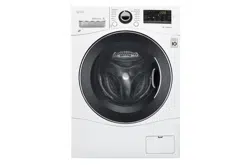Documents: Go to download!
User Manual
- User Manual - (English, French, Spanish)
- Specification - (English)
OWNER’S MANUAL Washing machine
PRODUCT OVERVIEW
Parts
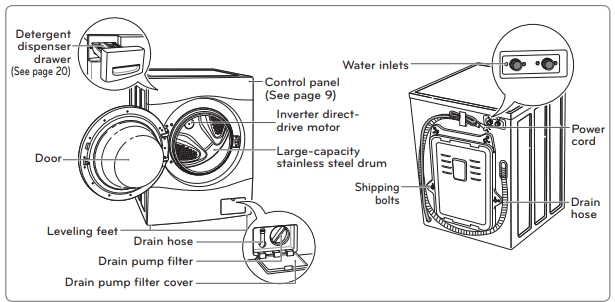
Accessories
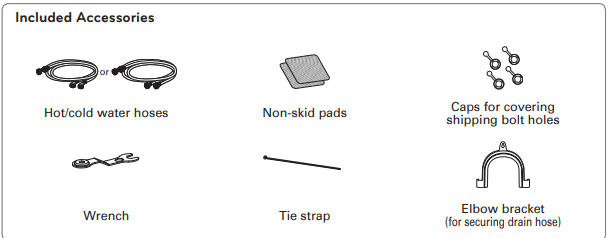
NOTE
- Contact LG Customer Service if any accessories are missing.
- For your safety and for extended product life, use only authorized components. The manufacturer is not responsible for product malfunction or accidents caused by the use of separately purchased unauthorized components or parts.
- The images in this guide may be different from the actual components and accessories, and are subject to change by the manufacturer without prior notice for product improvement purposes.
Control Panel Features
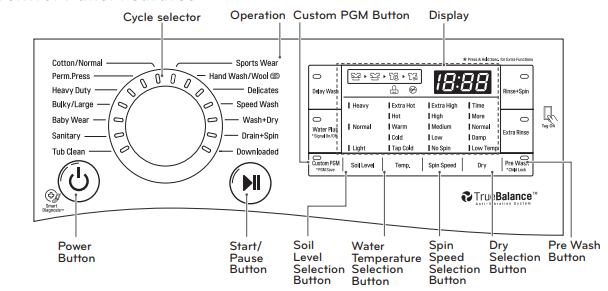
Operation

- Turns the washing machine on and off.
- (During the wash cycle) stops operation, and cancels the settings
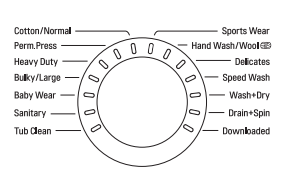
- Tub Clean - For tub clean
- Sanitary - For underwear, diapers, etc.
- Baby Wear - For lightly soiled baby clothes
- Bulky/Large - For blankets or large, bulky items
- Heavy Duty - For heavily soiled cotton fabric
- Perm. Press - For wrinkle-free fabric
- Cotton/Normal - For general laundry, such as cotton T-shirts or towels .
- Sports Wear - For high-performance fabrics which need special care
- Hand Wash/Wool - For wool or hand-wash fabrics
- Delicates - For sheer and delicate fabrics
- Speed Wash - For small quantities of lightly soiled items
- Wash+Dry - For a small load which can be washed and dried in the same cycle
- Drain+Spin - For items that only require draining and spinning

- Starts or pauses the wash cycle. - If you do not press the Start/Pause button within 4 minutes of selecting a cycle, the washing machine will turn off automatically and all settings will be lost.

- (Press repeatedly) Selects a wash cycle by soil level. - Selects soil level from 3 settings.

- (Press repeatedly) Selects the water temperature for the wash cycle (see page 25). - Select water temperature from 5 settings

- (Press repeatedly) Selects the spin speed. - Selects spin speed from 5 settings.

- (Press repeatedly) Selects a dry cycle. Pressing this button enables drying.

- Set the delay time of starting the cycle

- Use this option to add extra water to the wash and rinse cycles for better wash performance with large or bulky items.

- Use this option to save a special combination of settings that you use frequently

- Use this option to rinse detergent from the load

- Add an extra rinse to the selected cycle

- (Press before wash cycle) Pre wash heavily soiled laundry
- (Press and hold during wash cycle) Lock/Unlock the buttons
Display
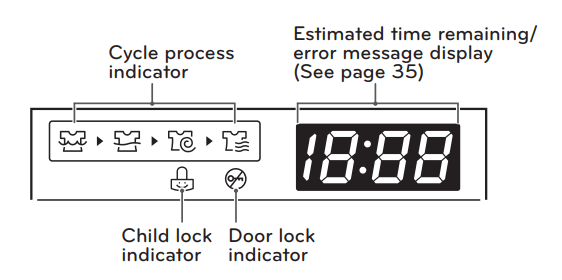
Display Icon
 This portion of the display shows which stage of the wash cycle is currently underway (Wash, Rinse, Spin, Dry).
This portion of the display shows which stage of the wash cycle is currently underway (Wash, Rinse, Spin, Dry).
 This indicator shows that the door is locked. The washer door will lock while the washer is operating. The door can be unlocked by pressing the Start/ Pause button to stop the washer.
This indicator shows that the door is locked. The washer door will lock while the washer is operating. The door can be unlocked by pressing the Start/ Pause button to stop the washer.
 This indicator shows that the washer has been set for Child Lock. The Child Lock function locks the buttons on the control panel to prevent them from being used.
This indicator shows that the washer has been set for Child Lock. The Child Lock function locks the buttons on the control panel to prevent them from being used.
 When the Start/Pause button is pressed, the washer automatically detects the wash load (weight) and optimizes the washing time, based on the selected cycle and options. The display will then indicate the estimated time remaining for the selected wash cycle.
When the Start/Pause button is pressed, the washer automatically detects the wash load (weight) and optimizes the washing time, based on the selected cycle and options. The display will then indicate the estimated time remaining for the selected wash cycle.
INSTALLATION
Installation Overview

WARNING
- Washer is heavy! Two or more people are required when moving and unpacking the washer. Failure to follow this warning can result in back or other injury.
- Store and install the washer where it will not be exposed to temperatures below freezing or exposed to outdoor weather conditions. Failure to follow this warning can cause serious injury, fire, electric shock, or death.
- Properly ground washer to conform with all governing codes and ordinances. Failure to follow this warning can cause serious injury, fire, electric shock, or death.
- To reduce the risk of electric shock, do not install the washer in humid spaces. Failure to follow this warning can cause serious injury, fire, electric shock, or death.
- The base opening must not be obstructed by carpeting when the washer is installed on a carpeted floor.
- Do not remove ground prong. Do not use an adapter or extension cord. Plug into a grounded 3-prong outlet. Failure to follow this warning can cause serious injury, fire, electric shock, or death.
Choosing the Proper Location
Install the washing machine on a solid floor that is strong and rigid enough to support the weight of the washing machine, even when fully loaded, without flexing or bouncing. If the floor has too much flex, you may need to reinforce it to make it more rigid. If the floor is not solid, it may cause severe vibration and noise.
- Clean the floor before installation. - Make sure to select solid and smooth ground.
- Two or more people are needed for moving and unpacking the washing machine.
- Allow for sufficient space between the walls and the washing machine for installation.
Space Requirements
- You must allow sufficient space for water lines, the drain line, and airflow.
- NOTE: Be sure to allow for wall, door, or floor moldings that may incr he required clearances
Clearances
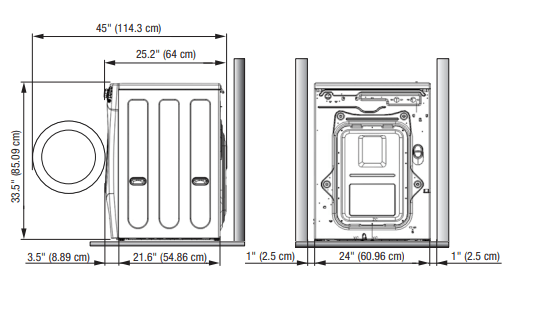
NOTE
- The floor must be strong and rigid enough to support the weight of the washer, when fully loaded, without flexing or bouncing. If your floor has too much flex, you may need to reinforce it to make it more rigid. A floor that is adequate for a top-loading washer may not be rigid enough for a front loading washer, due to the difference in the spin speed and direction. If the floor is not solid, your washer may vibrate and you may hear and feel the vibration throughout your house.
- Before installing the washer, make sure the floor is clean, dry and free of dust, dirt, water and oils so the washer feet can not slide easily. Leveling feet that can move or slide on the floor can contribute to excess vibration and noise due to poor contact with the floor.
- If a drip pan must be used, take extra care to follow the instructions provided with the drip pan and make sure the leveling feet are adjusted for firm and even contact with the pan. Use of drip pans and failure to properly level the machine may result in increased vibration and noise during operation.
Unpacking and Removing Shipping Bolts
- Remove the washer from the carton base.
- If you must lay the washer down to remove the base packaging materials, always lay it carefully on its side. Do not lay the washer on its front or back.
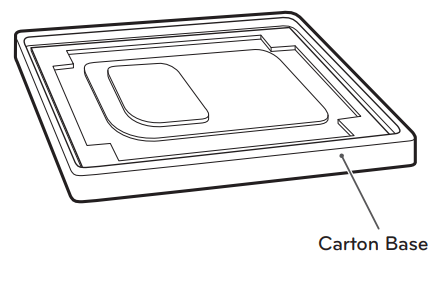
1 Starting with the bottom two shipping bolts, use the wrench (included) to fully loosen all four shipping bolts by turning them counterclockwise. Remove the bolt assemblies by wiggling them slightly while pulling them out.
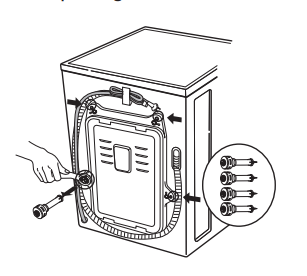
2 Locate the four hole caps included in the accessory pack and install them in the shipping bolt holes.

NOTE
- Save the bolt assemblies for future use. To prevent damage to internal components, do not transport the washer without reinstalling the shipping bolts.
- Failure to remove shipping bolts and retainers may cause severe vibration and noise, which can lead to permanent damage to the washer. The cord is secured to the back of the washer with a shipping bolt to help prevent operation with shipping bolts in place.
Connecting the Water Lines
1 Check the rubber seals on both sides of the hose. - Insert a rubber seal into the threaded fittings on each hose to prevent leaking

2 Connect the water supply hoses to the HOT and COLD water faucets tightly by hand and then tighten another 2/3 turn with pliers. - Connect the blue hose to a cold water faucet and the red hose to a hot water faucet.
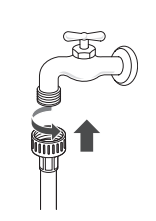
WARNING: Do not overtighten. Damage to the coupling can result.
3 After connecting the inlet hoses to the water faucets, turn on the water faucets to flush out foreign substances (dirt, sand or sawdust) in the water lines. Let the water drain into a bucket, and check the water temperature.
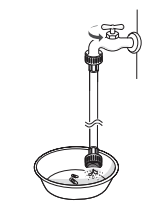
4 Connect the hoses to the water inlets tightly by hand and then tighten another 2/3 turn with pliers. - Connect the blue hose to the cold water inlet and the red hose to the hot water inlet.
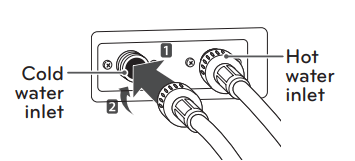
WARNING: Do not overtighten the hoses. Overtightening can damage the valves resulting in leaking and property damage.
5 Check for leaks by turning on the faucets. - If water leaks, check steps 1 to 4 again.
NOTE
- For your safety, and for extended product life, use only authorized components. The manufacturer is not responsible for product malfunction or accidents caused by the use of separately purchased, unauthorized parts.
- Use new hoses when installing the washing machine. Do not reuse old hoses.
- Contact LG Customer Service for Assistance in buying hoses
- Periodically check the hoses for cracks, leaks and wear, and replace the hoses every 5 years. Do not stretch the water hoses intentionally, and make sure that they are not crushed by other objects.
- Water supply pressure must be between 20 psi and 120 psi (138 – 827 kPA). If the Water supply pressure is more than 120 psi, a Pressure reducing valve must be installed.
- To provide optimum washing performance the hot water temperature should be set at 120 – 135°F (48-57°C) and the cold at 60°F (15°C).
Connecting the Drain Line
Secure the drain hose in place to prevent moving and leaking.
NOTE
- The drain hose should be properly secured. Failure to properly secure the drain hose can result in flooding and malfunction.
- Total height of the hose end should not exceed 96 inches (244.8 cm) from the bottom of the washer.
- The drain must be installed in accordance with any applicable local codes and regulations.
- Make sure that the water lines are not stretched, pinched, crushed, or kinked.
Using a Standpipe
1 Clip the end of the hose into the elbow bracket. - Connect the elbow bracket within 4 inches (10 cm) of the end of the drain hose. If the drain hose is extended more than 4 inches (10 cm) beyond the end of the elbow bracket, mold or microorganisms could spread to the inside of the washer.
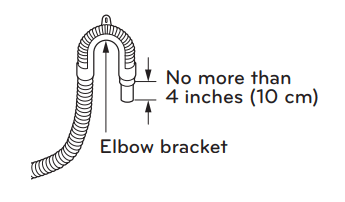
2 Insert the end of the drain hose into the standpipe.
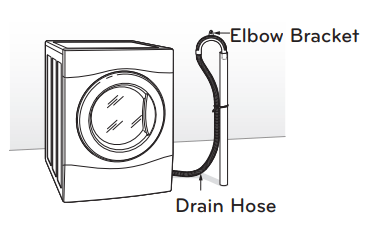
3 Use a tie strap to secure the drain hose in place.
Using a Laundry Tub
1 Clip the end of the hose into the elbow bracket. - Connect the elbow bracket within 4 inches (10 cm) of the end of the drain hose. If the drain hose is extended more than 4 inches (10 cm) beyond the end of the elbow bracket, mold or microorganisms could spread to the inside of the washer.

2 Hang the end of the drain hose over the side of the laundry tub.
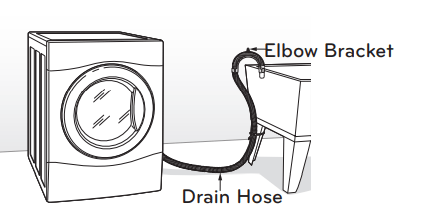
3 Use a tie strap to secure the drain hose in place.
Leveling the Washer
The drum of your new washing machine spins at very high speeds. To minimize vibration, noise, and unwanted movement, the floor must be perfectly level and solid.
1. Check that the washing machine is level. - Ensure it is level by rocking the top edges of the washing machine or placing a level on the washing machine. The slope beneath the washing machine must not exceed 1°, and all four leveling feet must rest firmly on the floor.

2 Turn the lower leveling feet clockwise to level the washing machine. - Turning the lower leveling feet clockwise raises the washing machine.

3 Turn the locknuts counterclockwise and tighten them when the washing machine is level.
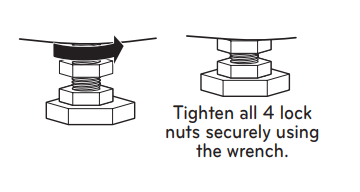
4 Check again to make sure the machine is level.
- Push or rock the top edges of the washing machine gently to make sure that the washing machine does not rock.
- If the washing machine rocks, repeat steps 1 to 3.
WARNING
- Using the washing machine without leveling, it may result in malfunction caused by the production of excess vibration and noise.
- If you are installing the washing machine on the optional pedestal, you must adjust the leveling feet on the pedestal to level the washing machine. The washing machine´s leveling feet should be minimized and the locknuts turned counterclockwise to secure them.
- Use the leveling feet only when you level the washing machine. If you raise the leveling feet unnecessarily, it may cause abnormal vibration of the washing machine.
Using Non-Skid Pads (Optional)
If you install the washing machine on a slippery surface, it may move because of excessive vibration. Incorrect leveling may cause malfunction through noise and vibration. If this occurs, lay the non-skid pads under the leveling feet and adjust the level.
- Clean the floor to attach the non-skid pads. - Use a dry rag to remove and clean foreign objects or moisture. If moisture remains, the non-skid pads may slip.
- Adjust the level after placing the washing machine in the installation area.
- Place the adhesive side of the non-skid pad on the floor. - It is most effective to install the non-skid pads under the front legs. If it is hard to place the pads under the front legs, place them under the back legs
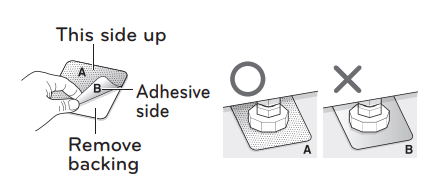
- Check the washing machine’s level again. - Push or rock the top edges of the washing machine gently to make sure that the washing machine does not rock. If the washing machine rocks, level the washing machine again.
Connecting to the Power Supply
Make sure to ground the washing machine to prevent a short circuit or an electric shock when plugging in.
Using a 3-Prong Outlet
If plugged into a grounded, 3-prong outlet rated for use with this appliance, no further grounding is necessary.

WARNING
- The power outlet must be within 60 inches (1.5 m) of either side of the washer.
- The appliance and outlet must be positioned so that the plug is easily accessible.
- Do not overload the outlet with more than one appliance.
- The outlet must be grounded in accordance with current wiring codes and regulations.
- Time-delay fuse or circuit breaker is recommended. y It is the personal responsibility and obligation of the product owner to have a proper outlet installed by a qualified electrician.
- Do not use a worn or damaged power cord or power plug. Replace or repair worn or damages cords or plugs it immediately. Failure to do so may result in death, fire, electric shock, or malfunction.
- Do not modify the power cord and take care not to damage it when installing or moving the washing machine. Failure to follow this warning may result in death, fire, electric shock, or malfunction.
- Make sure that the washing machine is grounded.
- Connect this washing machine to a grounded outlet conforming to the rating prior to use. Failure to do so may result in fire, electric shock, or malfunction.
- Do not use adaptors or extension cords. The washing machine should always be plugged into its own individual electrical outlet which has a voltage rating that matches the rating plate. Failure to do so may result in fire, electric shock or malfunction.
- Do not damage or cut off the ground prong of the power cord. Doing so may cause death, fire, electric shock, or product malfunction.
Testing the Washer
Check if the washing machine is properly installed and run a test cycle.
- Load the washing machine with 6 pounds of laundry (approximately 14 shirts).
- Press the Power button and turn the cycle selector knob to the right.
- Press the Rinse+Spin button to select Rinse+Spin.
- Press the Start/Pause button.
- The wash cycle starts.
- Check if water is supplied, that the washing machine does not rock or vibrate excessively, and that it drains well during the spin cycle.
- If water leaks during water supply, Connecting the water lines, to connect them properly.
- If the washing machine rocks and vibrates excessively, Leveling the washing machine, to level it again.
- If the drain does not work, Connecting the drain line, to install it properly.
PREPARATION
Sorting Wash Loads
Read and observe the following to prevent shrinkage or damage to clothes.
- Check all pockets to make sure that they are empty.
- Items such as clips, matches, pens, coins, and keys can damage both your washer and your clothes.
- Close zippers, hooks, and drawstrings to prevent these items from snagging or tangling on other clothes.
- Pretreat heavily stained areas before washing.
- Doing so will produce clean, stain-free results.
- Combine large and small items in a load. Load large items first.
- Large items should not be more than half of the total washload.
- The washer can be fully loaded, but the drum should not be tightly packed with items.
- The door of the washer should close easily.
- Do not wash single items, except for bulky items such as blankets. Make sure to wash laundry in similar types of loads.
- Washing a single small item may result in the tub becoming unbalanced, vibrating and making a noise.
- Do not wash waterproof clothes.
- This may cause abnormal vibration, or may cause the load to bounce, which could damage the tub.
- Check if there are any foreign objects in the door seal and take extra care that clothes do not get caught there.
- Foreign objects in the door seal may stain clothes, and water may leak if clothes get caught in the door seal.
- Wash underwear or small, light items in a laundry net (mesh bag).
- Small, light items may get caught in the door seal, and a brassiere hook may damage other items or the tub.
- Brush heavy soil, dust, or hair off fabrics before washing.
- Laundry may not wash clean if there is dirt or sand on the fabrics, or items may be damaged due to particles rubbing against sheer fabrics.
- Wash blankets individually.
- Washing more than one blanket in a load may produce inferior results due to tangling or an unbalanced load.
- Always separate fabrics according to their colors and wash them separately to prevent colors from running.
- Fabrics may be damaged or become stained due to fabric dyes running, or due to foreign objects transferring from one fabric to another.
- For best performance, load clothes as shown.
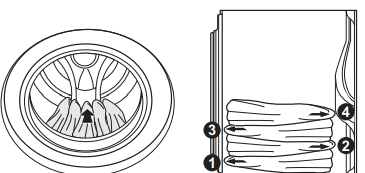
- Load clothes loosely, and do not overfill the drum. Clothes need room to circulate in order to get clean.
- Do not press down on items while stacking them in the drum.
Fabric Care Labels
Most articles of clothing feature fabric care labels that include instructions for proper care.
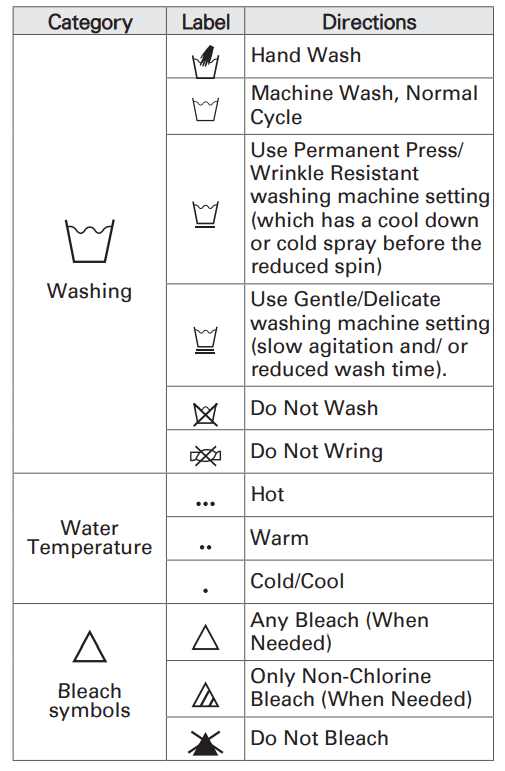
Sorting Laundry
- Sort laundry into similar loads that are washable in the same cycle.
- Refer to the following chart for sorting clothes.
- Colors: Whites / Lights / Darks
- Soil: Heavy / Normal / Light
- Fabric: Delicates / Easy Care / Sturdy Cottons
- Lint: Lint Producers / Lint Collectors
Using Detergent/Fabric Softener
Recommended Detergent
- Make sure to use HE (High-Efficiency) detergent for front-loading washing machines. HE detergents dissolve more efficiently and produce fewer suds to ensure efficient washing and rinsing. Use the correct amount of detergent as indicated on the detergent packaging.
- Specially designed to use only HE (High-Efficiency) detergent
- NOTE
- Only use HE detergents, because using a regular detergent may produce excessive suds.
- HE detergents produce fewer suds, dissolve more efficiently to improve washing and rinsing performance, and help to keep the interior of your washer clean.
- Use less detergent for soft water.
- Wipe up any spills immediately, as liquids could damage the finish and the control panel of the washing machine.
- Using too much detergent can cause a buildup in the tub resulting in unsatisfactory performance and machine malfunction.
- If you use a detergent that does not dissolve easily or a detergent with high viscosity, it will leave a residue on the tub, which may not rinse properly
Loading the Dispenser
The detergent dispenser drawer of the washing machine has a dispenser compartment for each detergent type. Add each detergent to its appropriate compartment
1 Pull out the detergent dispenser drawer.
2 Add each detergent to its appropriate compartment.
- If you use a liquid detergent, check if the liquid detergent cup is in place.
- If you use a powdered detergent, remove the liquid detergent cup and put the powder in the main wash detergent compartment.
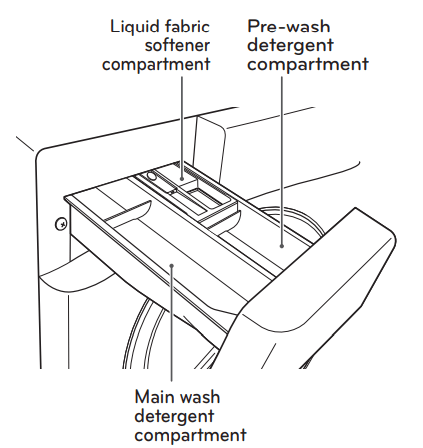
3 Close the detergent dispenser drawer slowly.
- Slamming the detergent dispenser drawer may result in the detergent overflowing into another compartment or pouring into the tub earlier than programmed.
NOTE: It is normal for a small amount of water to remain in the dispenser compartments at the end of the cycle.
Pre-Wash Detergent Compartment
Add liquid or powdered detergent to this compartment when using the Pre-Wash option. Always use HE (High-Efficiency) detergent with your washing machine.
NOTE
- When using the pre-wash option, if liquid detergent is to be used for the main wash, the liquid detergent cup accessory must be used in the main wash dispenser, to prevent the main wash liquid detergent from being dispensed immediately.
- The amount of detergent added for the Pre-Wash option is 1/2 the amount recommended for the main wash cycle. For example, if the main wash cycle requires one measure of detergent, add 1/2 measure for the Pre-Wash option.
Main Wash Detergent Compartment
This compartment holds laundry detergent for the main wash cycle, which is added to the load at the beginning of the cycle. Always use HE (High-Efficiency) detergent with your washing machine.
Never exceed the manufacturer’s recommendations when adding detergent. Using too much detergent can result in detergent buildup on clothing and the washer. Either powdered or liquid detergent may be used.
NOTE
- Liquid or powdered color-safe bleach may be added to the main wash compartment with detergent of the same type.
- When using liquid detergent, make sure the liquid detergent cup and insert are in place. Do not exceed the maximum fill line.
- When using powdered detergent, remove the insert and liquid detergent cup from the compartment. Powdered detergent will not dispense with the liquid detergent cup and insert in place.
Fabric Softener Compartment
This compartment holds liquid fabric softener, which will be automatically dispensed during the final rinse cycle.
NOTE
- Always follow the manufacturer’s recommendations when adding fabric softener. Do not exceed the maximum fill line. Using too much fabric softener may result in stained clothes.
- Dilute concentrated fabric softeners with warm water. Do not exceed the maximum fill line.
- Never pour fabric softener directly onto the load or into the drum.
OPERATION
Using the Washer
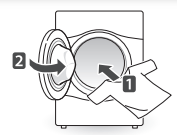 Load the laundry into the washing machine and close the door.
Load the laundry into the washing machine and close the door.  Press the Power button.
Press the Power button.
- The lights around the cycle selector knob will illuminate and a chime will sound.
 Turn the cycle selector knob in either direction to select the desired cycle.
Turn the cycle selector knob in either direction to select the desired cycle.
- The proper default option is automatically set according to the wash cycle.Cycle Guide, for more detailed default options for each cycle.
- Wash Cycles, for details on the wash cycles.
- To change the options, press the option button and select the desired option. Setting Options Before Cycle, for more details on options.
- Skip to step 4 to use the default setting without changing the options.
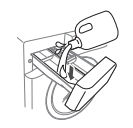 Add the proper amount of detergent and additions (bleach, softener) into the detergent dispenser drawer.
Add the proper amount of detergent and additions (bleach, softener) into the detergent dispenser drawer.
- Using Detergent/Fabric Softener, for more details on using detergent.
 Press the Start/Pause button.
Press the Start/Pause button.
- The washing machine will start.
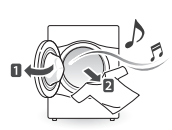 When the melody plays, the wash cycle is finished.
When the melody plays, the wash cycle is finished.
- When the washing cycle is finished, the door will unlock. Open the door and remove the laundry immediately.
- Make sure to check around the door seal when taking out the finished load. Small items may be caught in the door seal.
WARNING: To reduce the risk of fire, electric shock, or injury to persons, read the IMPORTANT SAFETY INSTRUCTIONS before operating this appliance.
NOTE:
- The front-load washing machine rotates the laundry in a way that allows it to use less water while still fully saturating your clothing. It is normal to not be able to see water during the wash cycle.
- If the temperature or the water level inside the machine is too high, the door locks and cannot be opened.
Wash Cycles
You can wash laundry items more thoroughly by selecting the wash cycle that best suits the type of items to be washed. Turn the cycle selector knob in either direction to select the desired cycle. When you select a wash cycle, the light for the corresponding wash cycle will turn on. Using the Washer, for more details on operating methods.
- Sanitary: Reducing Laundry Bacteria - This wash cycle helps to remove heavy soil on laundry through high temperature.
- Baby Wear: Lightly Soiled Baby Clothes - This cycle helps remove food stains from baby clothes using a powerful rinse.
- Bulky/Large: Blankets or Bulky Items - This cycle is for washing blankets or bulky items.
- Heavy Duty: Heavily Soiled Items - This cycle is for washing heavily soiled laundry through more powerful drum rotation.
- Perm. Press: Wrinkle-Free Items - This cycle is for washing items such as wrinkle-free clothes or tablecloths to minimize wrinkles.
- Cotton/Normal: Normal Items - Use this cycle to wash all normal items, except delicate fabrics such as wool or silk.
NOTE: If you press the Power button and the Start/ Pause button without selecting another cycle, the washing machine defaults to the Cotton/ Normal cycle
- Sports Wear: High-Performance Fabrics - Use this cycle for garments that are specially designed and treated for sports.
- Hand Wash/Wool: Items Labeled Wool or Hand-Wash - This cycle is for washing shrinkable woolen or hand-washable items requiring delicate care. Only wash woolen items that are labeled machine washable or hand-washable.
NOTE
- Laundry weight should be less than 8 pound (3.6 kg) to prevent damage to the fabric.
- Use only natural or wool-safe detergent harmless to fabrics and load 1/2 of the normal amount of detergent.
- The Hand Wash/Wool cycle uses a gentle tumble rotation angle and low speed spin for the ultimate fabric care.
- Delicates: Sheer Items - This cycle is for washing lingerie or sheer and lacy clothes which can easily be damaged.
- Speed Wash: Washing Quickly - Use the Speed Wash cycle to quickly wash lightly soiled clothing and small loads. For high wash and rinse efficiency, wash small loads of 2-3 lightly soiled garments
NOTE: Use very little detergent in this cycle. For additional rinsing, add an extra rinse using the option button.
- Wash+Dry: A Small Load Which Can Be Tumble Dried - This cycle washes and dries clothing in one continuous cycle.
- Drain+Spin: Drain and Spin Only - This cycle is for draining and spinning without the wash and rinse cycle, or for removing the load from the washing machine in the middle of the cycle.
Cycle Modifier Buttons
Each cycle has preset settings that are selected automatically. You may also customize the settings using the cycle modifier buttons. Press the button for that option to view and select other settings. The washer automatically adjusts the water level for the type and size of wash load for best results and maximum efficiency. It may seem there is no water inside the drum in some cycles, but this is normal
NOTE: To protect your garments, not every wash/ rinse temperature, spin speed, soil level, or option is available with every cycle. See the Cycle Guide for details
Setting Options Before Cycle
You can select and add the desired optional functions before you start the washing machine.
Soil Level: You can wash your laundry more thoroughly by setting the proper soil level on the washing machine.
- Press the Power button and turn the cycle selector knob in either direction to select the desired cycle.
- Press the Soil Level button repeatedly to select a soil level. - When you press the button, an indicator light for the corresponding selection will turn on in the display.
- You can now modify other cycle settings and add options, or proceed to step 4 to begin the cycle.
- Press the Start/Pause button.
NOTE: This feature will add time time for heavily soiled loads or subtract time for lightly soiled loads.
Temp.: Set the water temperature for the wash cycle. Set the appropriate temperature, as specified in the fabric care label.
- Press the Power button and turn the cycle selector knob in either direction to select the desired cycle.
- Press the Wash Temp button repeatedly to select the desired water temperature:
- When you press the button, an indicator light for the corresponding selection will turn on in the display.
- You can now modify other cycle settings and add options, or proceed to step 4 to begin the cycle.
- Press the Start/Pause button.
NOTE
- Cold rinses use less energy.
- Your washer features a heating element to boost the hot water temperature for Extra Hot settings. This provides improved wash performance at normal water heater settings.
- Select the water temperature suitable for the type of load you are washing. Follow the fabric care label for best results.
Spin Speed: You can set the desired spin speed. Use this feature properly according to the characteristics of the load.
- Press the Power button and turn the cycle selector knob in either direction to select the desired cycle.
- Press the Spin Speed button repeatedly to select the desired spin speed.
- When you press the button, an indicator light for the corresponding selection will turn on in the display.
- You can now modify other cycle settings and add options, or proceed to step 4 to begin the cycle.
- Press the Start/Pause button.
NOTE: The Spin Speed button also activates the Drain & Spin cycle to drain the tub and spin clothes; for example, if you want to remove clothes before the cycle has ended.
Dry:
- Press the Dry button to select drying options.
- For consistently dry loads, all articles in the load should be similar in material and thickness.
- Do not overload the drum. Items must have room to tumble freely.
- Press Start/Pause to remove items before the dry cycle has finished.
- Press the Dry button repeatedly to toggle through the selections:
- By pressing the Dry button, you can select:
- LOW TEMP. - For delicate fabrics
- DAMP - For damp drying fabrics
- NORMAL - For general drying
- MORE - For heavier fabrics
- 30/60/90/120- For timed drying
NOTE
- The capacity of the machine for washing clothes is twice as much as when drying clothes. If the machine is to be used to dry a load, then the wash load must be reduced by half for effective drying performance. If a full load is washed, remove half the clothes prior to starting the dry cycle.
Drying Guide–Automatic
- Dry Electronic sensors measure the temperature of the exhaust to increase or decrease the drying temperature for faster reaction time and tighter temperature control.
Recommended DRY settings by fabric type:
- Perm. Press – LOW TEMP.
- If clothes are to be ironed – DAMP
- Cotton/Towels – NORMAL
- Diapers – MORE
NOTE: On Automatic Dry settings, the estimated drying time may vary from the actual drying time. The type of fabric, size of the load, and the selected dryness level affect drying time
Drying Guide–Timed Dry
- Press the Dry button repeatedly to select the drying time in 30 minute increments: 30–60–90–120 minutes.
- Timed dry can last up to 120 min. When selecting Dry only, drying will start after the final Spin cycle.
- The time required to dry a load can vary greatly depending on dampness, room temperature, and type of fabric. You may need to add additional time. Your own experience will be your best guide
Drying Tips
Woolen Articles
- Do not tumble dry woolen articles. Block them (pull them to their original shape) and dry them flat.
Woven and Loopknit Materials
- Some woven and loopknit materials may shrink when dried.
- Always stretch them out immediately after drying.
Permanent Press and Synthetics
- Do not overload the dryer.
- To reduce wrinkles, take out permanent press articles as soon as the dryer stops.
Fiber or Leather Materials
- Always check the manufacturer’s instructions.
Baby Clothes and Night Gowns
- Always check the manufacturer’s instructions.
Rubber and Plastics: Do not dry any items made from or containing rubber or plastics, such as:
- Aprons, bibs, chair covers
- Curtains and tablecloths
- Bathmats
Fiberglass: Do not dry fiberglass articles in the dryer. Glass particles left in the washer could be picked up by clothes in the next load and irritate skin.
Delay Wash: Set the desired start time for the cycle.
- Press the Power button and turn the cycle selector knob in either direction to select the desired cycle.
- Modify the cycle settings and add other options, if desired.
- Press the Delay Wash button repeatedly to select the desired start time.
- The Delay Wash indicator light will turn on.
- The set start time appears on the display panel.
- Each press of the button increases the delay time by one hour, up to 19 hours.
- Press the Start/Pause button.
Water Plus: Use this option to add extra water to the wash and rinse cycles for better wash performance with large or bulky items.
- Press the Power button and turn the cycle selector knob in either direction to select the desired cycle.
- Press the Water Plus button..
- The indicator light will turn on.
- You can now modify other cycle settings and add options, or proceed to step 4 to begin the cycle.
- Press the Start/Pause button.
Rinse+Spin: Use this cycle to rinse detergent from the load.
- Press the Power button and turn the cycle selector knob in either direction to select the desired cycle.
- Press the Rinse+Spin button.
- Press the Spin Speed button repeatedly to set the spin speed.
- The indicator light for the selected spin speed will turn on.
- Press the Start/Pause button.
Extra Rinse: You can add an extra rinse cycle to the default rinse cycle.
- Press the Power button and turn the cycle selector knob in either direction to select the desired cycle.
- Press the Extra Rinse button.
- The Extra Rinse indicator light will turn on.
- You can now modify other cycle settings and add options, or proceed to step 4 to begin the cycle.
- Press the Start/Pause button
Pre Wash: Pre-wash for 17 minutes when clothes are covered in dirt or dust. This feature is suitable for heavily soiled items.
- Press the Power button and turn the cycle selector knob in either direction to select the desired cycle.
- Press the Pre Wash button.
- The indicator light will turn on.
- You can now modify other cycle settings and add options, or proceed to step 4 to begin the cycle.
- Press the Start/Pause button.
Signal On/Off: The washing machine plays a melody when the wash cycle is finished. The buttons make a sound each time a button is pressed.
- Press the Power button and turn the cycle selector knob in either direction to select the desired cycle.
- Press the Signal On/Off button.
- Press the Start/Pause button.
Setting Options During Cycle
You can add the desired options during the wash cycle.
Child Lock: You can lock the washing machine to prevent children or others from changing the cycle settings by pressing the buttons during the cycle.
- Enabling Child Lock: Press and hold the Pre Wash button for 3 seconds during the wash cycle.
- When the Child Lock is enabled, a message and the remaining wash time are displayed, in turn, on the display panel of the washing machine.
- Disabling Child Lock: (When the Child Lock is activated.) Press and hold the Pre Wash button for 3 seconds during the wash cycle. NOTE: Child Lock lasts after the end of the cycle. If you want to deactivate this function, press and hold the Pre Wash button for 3 seconds.
- PGM Save: Save a frequently used cycle with all the desired settings and options. Saving a Cycle
- Press the Power button and turn the cycle selector knob in either direction to select the desired cycle.
- Modify other cycle settings and add options
- Press and hold the Custom PGM button for 3 seconds during the wash cycle. The cycle with your preferred settings and options is saved.
Custom PGM: Recall the previously saved wash cycle and settings
- Recalling a Cycle
- Press the Power button, then press the Custom PGM button.
- Press the Start/Pause button.
Adding Garments
Garments can be added or removed after the cycle is started.
- Press the Start/Pause button.
- The door lock is released to open the door.
- Add or remove laundry.
- To continue the cycle, press the Start/Pause button again. The cycle continues automatically.
NOTE: For safety reasons, the door remains locked when the water level or temperature is high. It is not possible to add laundry during this time.
MAINTENANCE
Regular Cleaning
Care After Wash: After the cycle is finished, wipe the door and the inside of the door seal to remove any moisture. Leave the door open to dry the washer tub interior. Wipe the body of the washing machine with a dry cloth to remove any moisture.
WARNING
- Unplug the washer before cleaning to avoid the risk of electric shock. Failure to follow this warning can cause serious injury, fire, electric shock or death.
- Never use harsh chemicals, abrasive cleaners, or solvents to clean the washer. They will damage the finish.
- Do not use volatile substances (benzene, paint thinner, alcohol, acetone, etc.) or detergents with strong chemical components when cleaning the washing machine. Doing so may cause discoloration or damage to the machine, or it may cause a fire.
Care in Cold Climates
Long-Term Storage: Follow these instructions when storing the washer for an extended period where it might be exposed to freezing temperatures.
- Turn off the faucets connected with the water lines.
- Unscrew the water lines from the back of the washer.

- Empty any water out of the water lines.
- Press the Power button.
- Open the door and add 1 gallon (3.8 L) of nontoxic recreational vehicle (RV) antifreeze to the empty washer tub. DO NOT use automotive anti-freeze. Close the door.
- Press the Spin Speed button for draining and spinning.
- Press the Start/Pause button.
- Drain the water from the washing machine for 1 minute. Not all of the RV antifreeze will be expelled.
- Press the Power button to turn off the washing machine and pull out the power plug.
- Dry the interior of the washer tub with a soft cloth, and close the door.
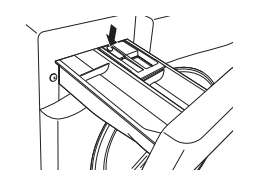
- Press down hard on the disengage button and pull out the detergent dispenser drawer.
- Drain the water from the detergent dispenser drawer and dry out each compartment.
- Store the washing machine in an upright position.
NOTE: To remove the antifreeze after storing the washing machine, add detergent to the dispenser, and run one cycle. Do not load any laundry at this time.
Thawing Frozen Water Lines:
- Turn off the faucets connected with the water lines.
- Pour hot water on the frozen faucets to thaw the water lines and pull them out.
- Immerse the water lines in hot water to thaw them.
- Connect the water lines with the water inlets of the washing machine and faucets.
- See page 14, Connecting the water lines for details.
- Turn on the faucets.
- Press the Power button.
- Press the Rinse+Spin button.
- Press the Start/Pause button. - Verify the water fills properly.
Thawing a Frozen Drain Line
- Pour hot water in the washer tub and close the door.
- Leave it for 10 minutes.
- Press the Power button after 10 minutes.
- Press the Spin Speed button for draining and spinning.
- Press the Start/Pause button.
- Check if the water drains.
Cleaning
Periodically clean the washing machine to help maintain its performance and to minimize the chance of malfunction.
Tub Clean: Improper installation or use of the washing machine in a humid space for a long period of time could lead to a buildup of detergent residue in the washing machine that may produce mildew or musty smells. If you clean the washer tub regularly on a monthly basis using Tub Clean it will minimize the possibility that detergent residue will build up and mildew or musty smells may occur.
- Add tub cleaner or lime scale remover into the detergent dispenser drawer.
- Do not exceed the maximum detergent limit line when you add it. Detergent may remain in the washer tub after cleaning.
- When you use liquid chlorine bleach, load it into the liquid chlorine bleach compartment.
- When you use a powdered cleaner, pull out the liquid detergent cup and add it into the main wash detergent compartment.
- When you use cleaning tablets, place them directly into the washer tub. (Do not add tablet cleaner to the drawer.)
- Press the Power button.
- Turn the cycle selector knob to select Tub Clean.
 message appears in the display.
message appears in the display.- The indicator light for Tub Clean turns on.
- Press the Start/Pause button.
Automatic Alert
- When the power is on and the
 message blinks, it means the washer tub needs cleaning. Use Tub Clean to clean the washer tub. The automatic indicator alert for cleaning the washer tub depends on the frequency of use, however, the message will generally blink every 1~2 months.
message blinks, it means the washer tub needs cleaning. Use Tub Clean to clean the washer tub. The automatic indicator alert for cleaning the washer tub depends on the frequency of use, however, the message will generally blink every 1~2 months.
Removing Mineral Buildup
- If you live in an area with hard water, mineral scale can form on the internal components of the washing machine. Take extra care to periodically clean the mineral buildup on the internal components to extend the lifespan of the washing machine.
- Check if the descaler is suitable for cleaning the washer tub before using it and run the Tub Clean cycle. See page 30, Tub clean for details on tub clean.
Removing Lime Buildup on Stainless Steel
- Wipe lime buildup or other spots on stainless steel with a soft cloth soaked in stainless steel cleaner.
- NOTE: Never use steel wool or abrasive cleansers. Doing so may damage the washing machine.
Cleaning the Detergent Dispenser Drawer
Leaving detergent in the detergent dispenser drawer for an extended period of time or using the washing machine for a long period of time may cause the build-up of scales in the detergent dispenser drawer. Pull out and clean the detergent dispenser drawer once a week.
- Pull out the detergent dispenser drawer.
- Press down hard on the disengage button and pull out the detergent dispenser drawer.

- Remove the inserts from the drawer.
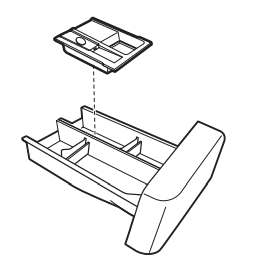
- Clean them with warm water.
- Use a soft cloth or brush for cleaning and remove any residue.
- Wipe any moisture with a dry towel or cloth after cleaning.
- Replace the detergent dispenser drawer.
Cleaning the Water Inlet Filters
Clean the water inlet filters periodically to prevent clogging. Take extra care to clean the water inlet filters in areas using hard water. Water may not be supplied if there are foreign objects, such as rust, sand, or stones in the water inlet filters.
- Press the Power button to turn off the washing machine and pull out the plug.
- Turn off the faucets connected with the water inlets.
- Remove the water inlets.
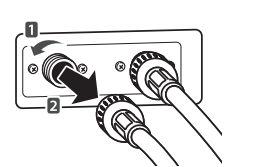
- Pull out the water inlet filter

- Remove foreign objects from the water filter inlet.
- Soak the water filter inlets in white vinegar or a lime scale remover or use a toothbrush to remove foreign objects and rinse thoroughly.
- Press the water filter inlets back into place.
- Reattach the water lines to the washing machine.

Cleaning the Drain Pump Filter
The washing machine fails to drain if the drain pump filter is clogged. Periodically clean the drain filter to prevent clogging with foreign objects.
- Press the Power button to turn off the washing machine and pull out the plug.
- Open the drain pump filter cover
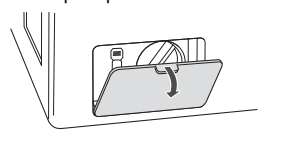
- Unclip the drain hose and remove the plug from the drain hose to drain the remaining water.
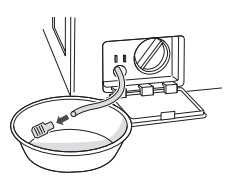
- Twist the pump filter counterclockwise to remove it.

- Clean the pump filter and opening.
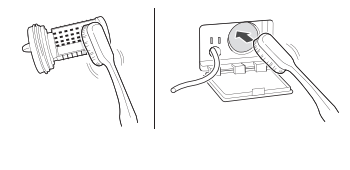
- Recap the plug onto the drain hose and reattach the drain hose.
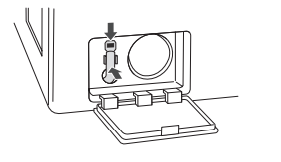
- Insert the drain pump filter.
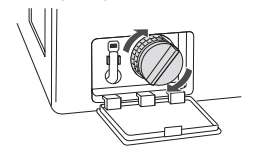
- Close the drain pump filter cover.
Cleaning the Door Seal
Clean the door seal once a month to prevent buildup of dirt in the door seal.
- Wear rubber gloves and protective goggles. 2 Dilute 3/4 cup (177 ml) of liquid chlorine bleach in 1 gallon (3.8 L) of water.
- Soak a sponge or a soft cloth in this diluted solution and wipe down all around the door seal.
- Wipe any moisture with a dry towel or cloth after cleaning.
- Leave the door open to allow the door seal to dry completely.
TROUBLESHOOTING
Checking Error Messages
If the following message appears on the display, check the following and take the appropriate corrective action.
Message -- Possible Causes --- Solutions

Possible Causes: Item of clothing has gathered on one side of the tub.
- There are not enough items in the machine.
- Have your items gathered in one area, or is the load too small?
- Did you wash a stuffed animal, a mat, or knitwear?
- Did you wash two different blankets together?
Solutions
- Rearrange items to help balance the load.
- Stuffed animals or mats can become unbalanced during spinning and the washing machine may fail to drain. Rearrange the knitwear to help balance the load and drain it again.
- Put one blanket in at a time.

1. Possible Causes: Water is not supplied or the water pressure is low
- Is the faucet turned off?
- Is the water supply stopped or the faucet frozen?
- Is the water pressure low or is an inlet filter clogged?
- Is the water line properly connected with the cold water inlet?
- Is the water line pinched or bent?
Solutions
- Turn on the faucets.
- If a faucet is frozen, thaw it with warm water. y If the inlet filter is clogged, clean it. (see page 32) y Connect the water line properly with the cold water inlet. (see page 14) y Check that the water lines are not pinched or bent. Take extra care that water lines are not twisted or pinched by other objects
2. Possible Causes: Water line leaks in connection
- Are the water lines connected with the faucets properly?
Solutions
- Connect the water lines properly with the faucets.

Possible Causes: The tub does not rotate
- Is the door secured?
Solutions
- Close and secure the door. If the message keeps appearing, unplug the power and contact your nearest LG service center

Possible Causes: The washing machine drains slowly or not at all
- Is the drain hose installed over 3 1/4 feet (1 m) beyond the end of the elbow bracket?
- Is the drain hose pinched or clogged inside?
- Is the drain hose frozen?
- Is the drain hose clogged with foreign objects?
Solutions
- Lower the drain hose within 3 feet below the end of the elbow bracket.
- Place the drain hose on a smooth surface to prevent bending.
- If the drain hoses are frozen, thaw them in warm water.
- Open the drain pump plug cap and remove the dirt

Possible Causes:A power failure has occurred.
Solutions: Press the Power button to turn off the washing machine and press it again to turn it on.

Possible Causes:Control Error.
Solutions: Unplug the power cord and contact your nearest LG service center.

Possible Causes:The water supply does not stop
- Do the water supply and the drain keep repeating in turn?
Solutions: Unplug the power cord and contact your nearest LG service center

Possible Causes:The water level is not controlled
- Is the water level too low or high compared with the size of the load?
Solutions:
- The water level sensor is not working correctly.
- Unplug the power cord and contact your nearest LG service center.

Possible Causes: The tub does not rotate
- Is the washing machine overloaded?
Solutions:
- Rearrange the load size and restart the washing machine.
- If the load size is big, the tub may not rotate due to an overheated motor. Allow the washing machine to stand for a while and restart the cycle. Unplug the power cord and contact your nearest LG service center if the same error message appears

Possible Causes: To clean up the tub, please run the TUB CLEAN cycle.
Solutions:
- Please empty the tub and insert bleach into the detergent dispenser and select the Tub Clean cycle.
- If you want to skip the Tub Clean, turn the CYCLE SELECTOR KNOB or push the option buttons to select a cycle. The message will keep appearing until a few wash cycles have been completed, then it will disappear until the next scheduled time to clean the tub.
Before Calling for Service
Check the following before calling for service.
Problem -- Possible Causes -- Solutions
1. Clicking sound
- Do you hear a sound when you close or lock and unlock the door?
- This sound is normal and occurs when the door is closed, locked or unlocked.
2. Spraying or hissing sound
- Is water spraying in the tub?
- This sound is normal as water is spraying or circulating during the cycle.
3. Buzzing or gushing sound
- Is the washing machine draining water?
- This sound is normal as the drain pump drains water from the washing machine after the cycle.
4. Splashing sound
- Is the washing machine washing a load of laundry?
- This sound is normal as the load is moving up and down during the wash and rinse cycles.
5. Rattling and clanking noise
- Are there any foreign objects such as keys, coins, or safety pins in the tub or drain filter?
- Check if there are any foreign objects in the tub and drain the filter after stopping the cycle.
- Unplug the power cord and contact your nearest LG service center if the noise persists.
6. Thumping sound
- Is the washing machine overloaded?
- Is the load out of balance?
- This sound is normal and occurs when the load is out of balance. Stop the cycle and rearrange the load for balancing.
7. Vibrating noise
- Are the shipping bolts removed?
- Is the load evenly distributed in the tub?
- Is the washing machine level balanced?
- Is the washing machine installed on a solid and smooth surface?
- See page 13, Unpacking and Removing Shipping Bolts, to remove the shipping bolts.
- Stop the cycle and rearrange the load for balancing.
- See page 16, Leveling the Washer, to level the washing machine.
- Check if the floor is solid and level.
8. Water leaking around washer
- Is water leaking from a faucet or a water line?
- Is a drain pipe or a drain hose clogged?
- Check the faucets or water lines. If the water lines are loosely connected, see page 14, Connecting Water Lines, to connect them properly.
- Unclog the drain pipe or drain hose. Contact a plumber if necessary.
9. Excessive suds or failure to rinse
- Did you use more than the recommended amount of detergent?
- Is the soil level higher than the size of the load?
- Use the recommended amount of detergent for the load.
- If the soil level is low, reduce the detergent quantity to less than the recommended level.
10. Staining
- Did you add detergent directly to the tub?
- Did you remove the load immediately after it finished?
- Did you sort and wash the clothes by color or soil?
- y Make sure to load detergent into the detergent dispenser drawer.
- Remove the load immediately after it finishes.
- Sort and separate dark colors from light or white ones, and heavily soiled items from lightly soiled ones. See page 19, Sorting Laundry, for details
11. Wrinkling
- Did you remove the load immediately after it finished?
- Did you overload the tub?
- Did you reverse the hot and cold water inlets?
- Remove the load immediately after it finishes.
- Do not overload the tub.
- Hot water rinse can cause garments to wrinkle. Check the inlet hose connections.
12. Power will not turn on
- Is the power cord plugged in properly?
- Has a house fuse blown, a circuit breaker tripped, or a power outage occurred?
- Make sure that the plug is secured in a grounded 3-prong, 120 V (60 Hz) outlet.
- Reset the circuit breaker or replace the fuse. Do not increase the fuse capacity. If the problem is a circuit overload, have it corrected by a qualified electrician.
13. The door does not open when the cycle pauses or finishes
- Is the temperature in the tub too high?
- Is the water level in the washer high?
- The washing machine has a safety lock built into the door to prevent burning. Leave the door closed and wait until the door lock icon disappears from the display.
- Allow the washer to complete the programmed cycle, or press the SPIN button
14. The wash cycle time is longer than usual
- Is the washing machine overloaded? Are other options added to the wash cycle?
- This is normal. The washing machine automatically adjusts the cycle time for the amount of laundry, water pressure, water temperature, and other operating conditions
15. It is musty or moldy in the tub
- Has the incorrect detergent been used?
- Did you clean the tub periodically?
- Use only HE (High-Efficiency) detergent recommended for a front-loading washing machine.
- See page 30, clean the inside and outside of the washing machine periodically
16. Banging noise when washer is filling with water (Water Hammer)
- Plumbing in the home moves or flexes when the water valves in the washer shut off.
- Household water supply pressure is very high.
- Water hammer is not caused by a defect in the washer. Install water hammer arrestors (purchased separately at hardware or home improvement store) between the fill hose and the washer for best results.
- Adjust household water supply regulator to a lower pressure or contact a plumber to have a regulator installed.
17. Strange odors coming from washer
- Heater in dryer.
- First time using washer
- Buildup of dirt on gasket or drum, dirty or clogged drain pump filter, kinked or clogged drain hose
- During the initial phase of operation, lint from laundry can settle on the heater and cause odors. This is normal and will not affect performance.
- Smell comes from the rubber attached to the washer door. It will eventually dissipate after first couple of wash cycles.
- Periodically clean the gasket. Mold and foreign substances inside the gasket may produce mildew or musty smells.
- Clean the drain pump filter regularly. Foreign substances on the drain pump filter may produce mildew or musty smells.
- If the drain hose is not installed properly, the odor may be emitted because of a backflow of drainage into the tub. Make sure that the drain hose is not kinked or clogged.
See other models: LFX25961SW LGVX8000 LGVK410 60UF7300 LGQ710PL
